Charles E W Bean, Diaries, AWM38 3DRL 606/275/1 - 1918 - 1938 - Part 20





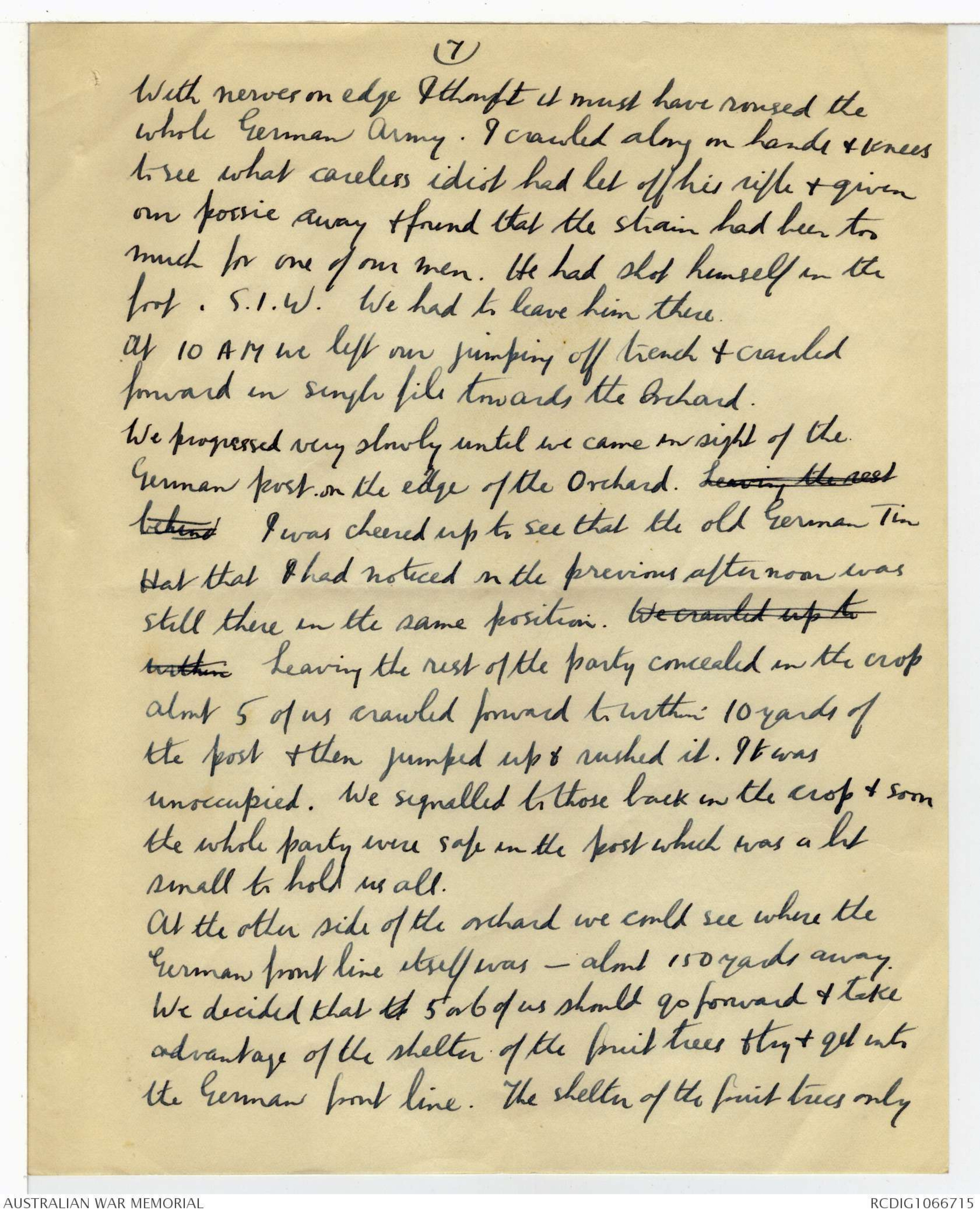
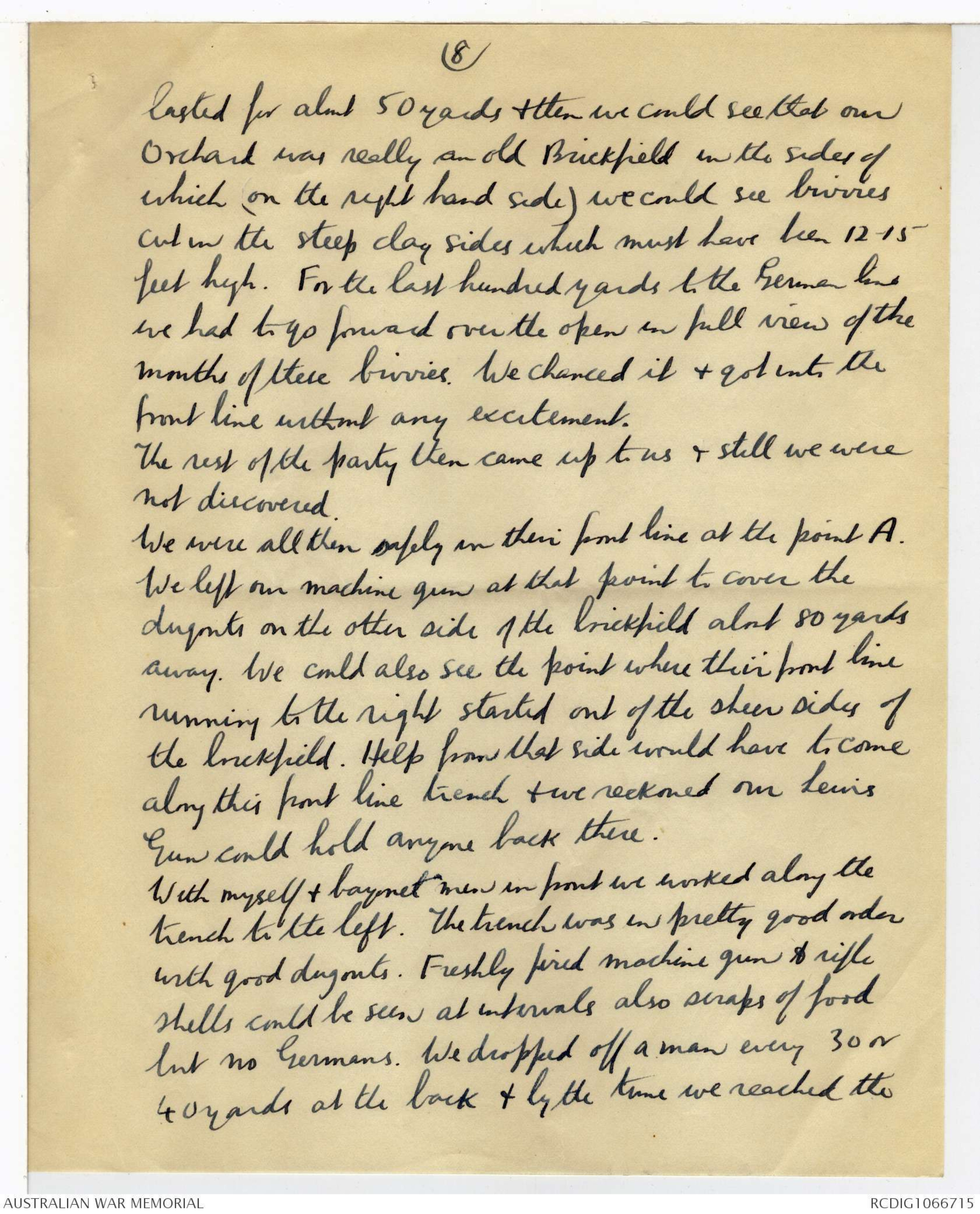
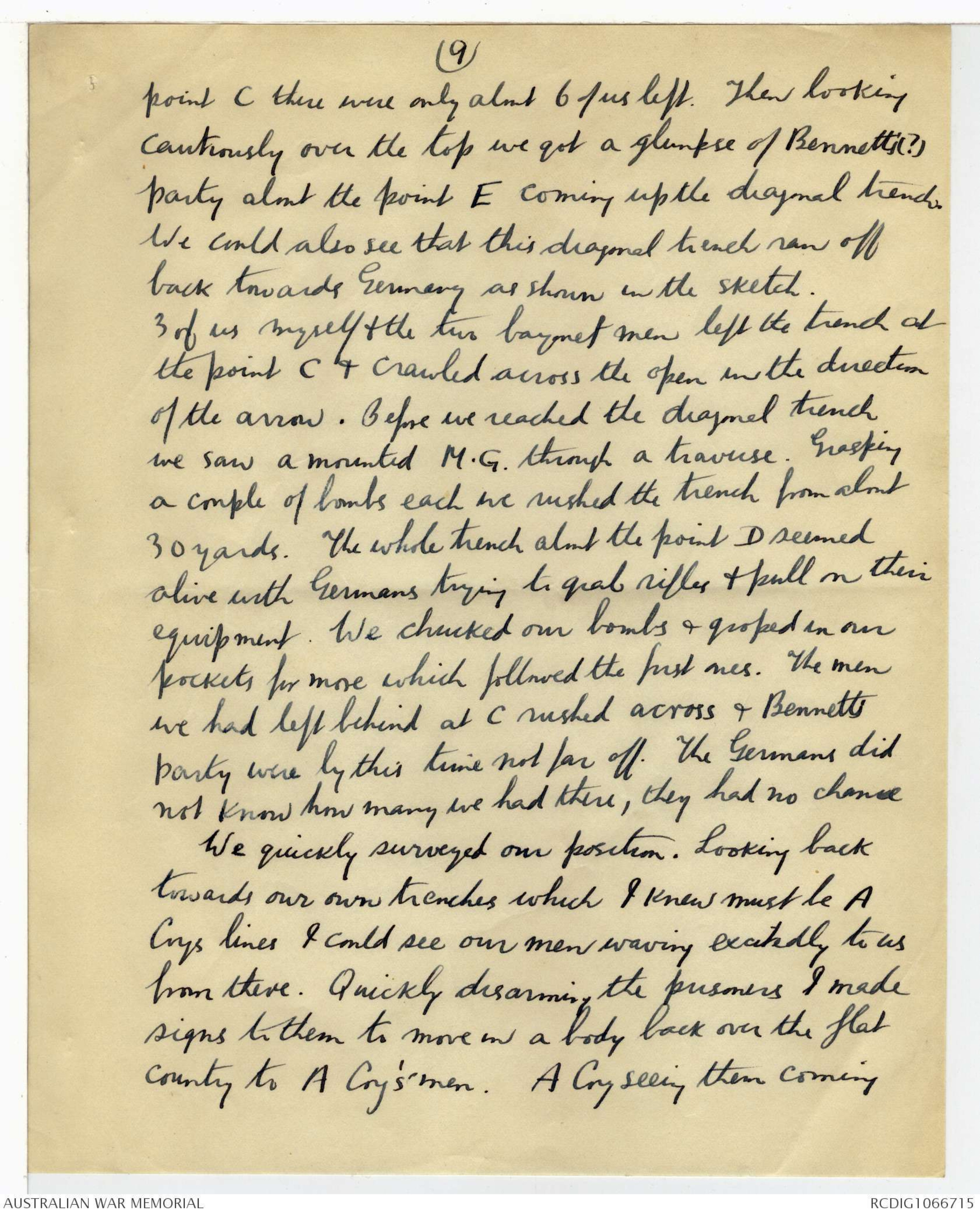
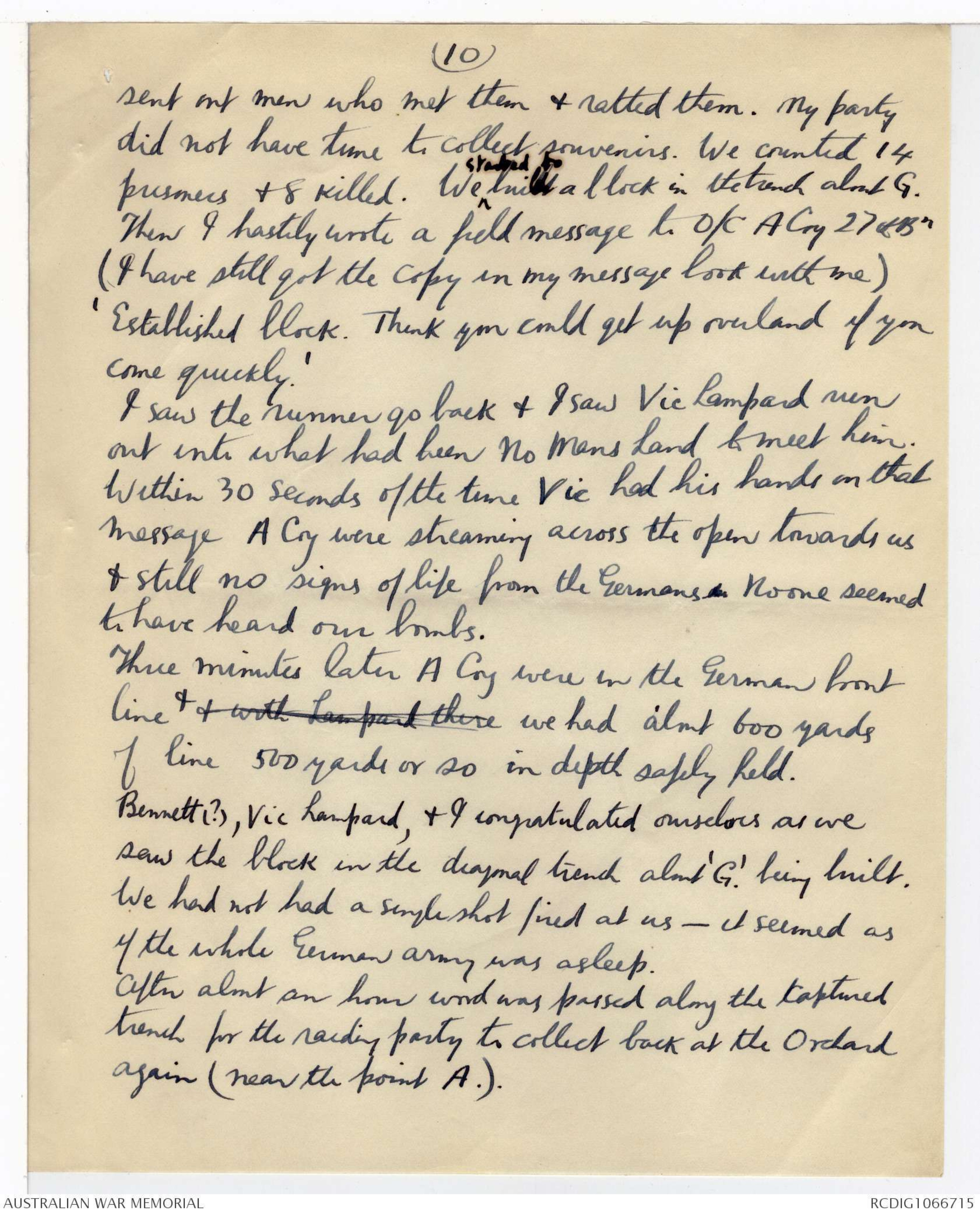
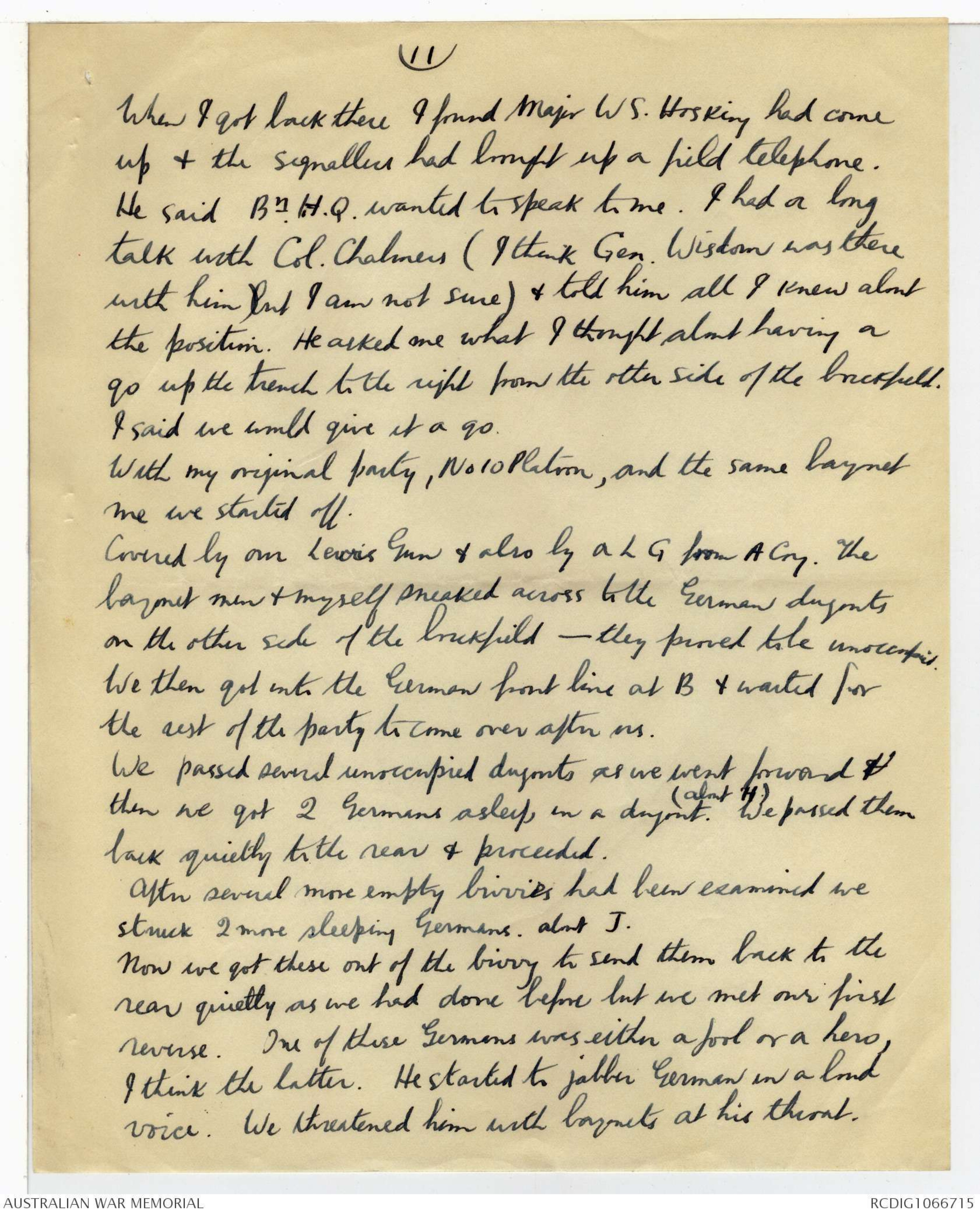
2
doubtful because although I was the youngest officer in the 27th I
had seen enough service to know that we had no chance on earth
of getting into their lines if the sentries saw us coming.
As I walked through Villers Brett. on the way up to have a
look at the possie I got up to the top story of a house where
I could get a good look at the German lines out in front &
tried to compare the ground with my aerial photographs.
The only position I was sure of in my sector was “the
Orchard” as we used to call it. (You have called it ‘the
Crickfield’ in your letter). I was pretty familiar with ‘the
Orchard’ as one of our heavy T.M.B's (the Flying Pigs)
used to have a shot at this position nearly every afternoon
& we often watched their shooting from 'the keeps.’
It looked to me as if the best way into the German front line
(which showed on my aeroplane phots. as running out of the
back of the orchard) might be through the orchard.- I
went up to have a look.
I will give you from memory my route up as although not
to scale it may help you to locate it on your trench maps.
At the edge of Villers B. a sap started somewhere in the middle of
some houses. & entered our reserve line somewhere about ‘2’
200 yards (?) South of the road. As it was about midday I had
to go up by the C.T. to keep out of sight (by night we used
to go overland.) along our reserve line through the road, -
& then on for 600 or 700 yards (?) to ^'Y’ where a shallow C.T.
3
lead up to the front line. D. Coy 27th (Capt. R. G Horwood MM
was commanding them while Major WS. Hosking was not in)
Bn were holding the line.
I dug up Ron Horwood & told him I was going out to have
a look at the Orchard & asked him to warn his coves
to be careful & let me in when I came back.
He & I together went along to a point nearly opposite to
the orchard (about point X). There was a growing crop
out in no man's land about 1'6" – 2' high which looked
good to me. I crawled through the crop towards the
Orchard & about 200 yards out ahead crossed an old trench
2' or 3' deep in the middle of the crop. (This ultimately
formed the assembly place of the raiding party). I kept
on through the crop until I was stopped by what looked to
be a strong post just on the edge of the Orchard. (marked W).
I could see a German Tin Hat on the parapet of this
post. I crawled to within 30 yards of the post & lay there
for about 2hours to see if I could find out whether the
it was occupied. I nearly went to sleep in the sun when
our Flying Pig (Heavy T.M.Bs) Battery from the edge of Villers
Brett. opened up on the Orchard & its first 4 shots fell
between me & my own front line. I got out to a flank
quietly & back to D Coy's lines feeling fed up with the
short shooting of the Flying Pigs. I was frightened of that
Germen post W because even if we rushed it from the crop
4
I reckoned it would give warning to the Main German front line
about 150 or 200 yards further on at the other side of the
Orchard. I reported back to Bn HQ & told Col. Chalmers
all about it & he got in to Brigide by telephone. We decided
to have a go at it with my platoon No. 10. next morning
at 10 A.M. It was arranged that a second party (I think
under Lt Bennett) were to leave our lines about half an
hour after we kicked off & work their way up the a
diagonal trench which I suppose must have run right across
no mans land starting from a point F. These people were
to try & help us if we ever get far enough along the German
front line to make contact with them.7thQ. H.Q. made it clear that they wanted the trench held
if possible but I could see they had no faith in the scheme
at all & I was given to understand that if we got hung
up getting into the German post line we were to get back
as best we could & the whole thing would have to be done
properly with Artillery preparation.
Before leaving Bn HQ with practically enforce hand I extracted
a promise that they would keep the Flying Pig Battery
quiet while we were out there
I went back to my platoon & broke the news gently. This was
as far as I am aware the first daylight raid we had
ever encountered (It was I think before the Meteren raids
of the 1st Diviry) and everyone thought it was suicide but
5
being some of the finest swaddies in the world they refrained
from saying so. I dropped out 3 or 4 of the platoon who
were obviously not cut out for raiders & got volunteers
from the rest of the Coy to make our strength up to 26
O.Rs & myself. Sgt Carter & Cply Fred Boughen were
to be bayonet men to lead & Pte(?) Claude Crocker
my No 1 Machine gun man.
I showed them all my plan which was roughly as follows -
Before daylight we would go out through the crop & occupy
the old trench in the crop that I had discovered in my
reconnaissance of that afternoon. We would lie there
(it was not deep enough to kneel up in) until 10 A.M.
At 10 AM we would crawl out in single file through
the crop until we came to the German post. I had seen.
The bayonet men & 3 or 4 others would sneak up to this
& then rush it. After that we would try & get into the
German front line about 150 yards ahead & then leaving
our Lewis Gun to guard the rear would try & bomb
our way as for as we could to the left. As we
went we would drop a man every 30 yards or so at
our rear to hold the trench we had taken.
I took the party up to our front line about 1am. 1 a.m.
and left them in D Coys lines while I went along.
6
our front line lo the left to A Coys lines (Lt LAMPARD O.C).
Vic Lampard who was killed shortly afterwards was one
of the finest little soldiers I ever met. - he was an
inspiration to me. He said that the country ahead of him
was quite flat and if we had the good luck to get
for enough along the German line to get opposite to him
he would help us to the last ounce. He said that he had
not noticed a single sign of German activity opposite
to him during daylight & he doubted if the Germans
occupied their line by day. He was the first Cheer Up.
society I had met.
I went back to No 10 Platoon & about 3 oclock (it
got light very early) we got out of our trench and
occupied the old trench out in front.
We settled down for a long wait of about 7 hours. We could
not move about owing to the shallowness of the trench.
Knowing what was ahead of them it was a tremendous strain
on the men.
We watched the German front line for signs of activity
and as it got lighter there were several bursts of machine
gun fire & some rifle shots from there.
We tried to sleep but sleep is not easy under such
conditions.
At about 10 minutes to 10 oclock (10AM was our zero hour)
there was a shot from a rifle along our own trench.
7
With nerves on edge I thought it must have roused the
whole German Army. I crawled along on hands & knees
to see what careless idiot had let off his rifle & given
our possie away & found that the strain had been too
much for one our men. He had shot himself in the
foot. S.I.W. We had to leave him there.
At 10 AM we left our jumping off trench & crawled
forward in single file towards the Orchard.
We progessed very slowly until we came in sight of the
German post on the edge of the Orchard. Leaving the rest behind I was cheered up to see that the old German Tin
Hat that I had noticed on the previous afternoon was
still there in the same position. We crawled up towithin Leaving the rest of the party concealed in the crop
about 5 of us crawled forward to within 10 yards of
the post & then jumped up & rushed it. It was
unoccupied. We signalled to those back in the crop & soon
the whole party were safe in the post which was a bit
small to hold us all.
At the other side of the orchard we could see where the
German front line itself was - about 150 yards away.
We decided that 4 5 or6 of us should go forward & take
advantage of the shelter of the fruit trees & try & get into
the German front line. The shelter of the fruit trees only
8
lasted for about 50 yards & then we could see that our
Orchard was really an old Brickfield in the sides of
which on the right hand side) we could see bivvies
cut in the steep clay sides which must have been 12-15
feet high. For the last hundred yards to the German line
we had to go forward over the open in full view of the
mouths of these bivvies. We chanced it & got into the
front line without any excitement.
The rest of the party then came up to us & still we were
not discovered.
We were all then safely in their front line at the point A.
We left our machine gun at that point to cover the
dugouts on the other side of the brickfield about 80 yards
away. We could also see the point where their front line
running to the right started out of the sheer sides of
the brickfield. Help from that side would have to come
along this front line trench & we reckoned our Lewis
Gun could hold anyone back there.
With myself & bayonet men in front we worked along the
trench to the left. The trench was in pretty good order
with good dugouts. Freshly fired machine gun & rifle
shells could be seen at intervals also scraps of food
but no Germans. We dropped off a man every 30 or
40 yards at the back & by the time we reached the
9
point C there were only about 6 of us left. Then looking
cautiously over the top we got a glimpse of Bennett's(?)
party about the point E coming up the diagonal trench.
We could also see that this diagonal trench ran off
back towards Germany as shown in the sketch.
3 of us myself & the two bayonet men left the trench at
the point C & crawled across the open in the direction
of the arrow. Before we reached the diagonal trench
we saw a mounted M.G. through a traverse. Grasping
a couple of bombs each we rushed the trench from about
30 yards. The whole trench about the point D seemed
alive with Germans trying to grab rifles & pull on their
equipment. We chucked our bombs & groped in our
pockets for more which followed the first ones. The men
we had left behind at C rushed across & Bennetts
party were by this time not far off. The Germans did
not know how many we had there, they had no chance
We quickly surveyed our position. Looking back
towards our own trenches which I knew must be A
Coys lines I could see our men waving excitedly to us
from there. Quickly disarming the prisoners I made
signs to them to move in a body back over the flat
County to A Coy's men. A Coy seeing them coming
10
sent out men who met them & ratted them. My party
did not have time to collect souvenirs. We counted 14
prisoners & 8 killed. We ^started to build a block in the trench about G.
Then I hastily wrote a field message to O/C A Coy 27th Bn
(I have still got the copy in my message book with me)
'Established block. Think you could get up overland if you
come quickly.'
I saw the runner go back & I saw Vic Lampard run
out into what had been No Mans Land to meet him.
Within 30 seconds of the time Vic had his hands on that
message A Coy were streaming across the open towards us
& still no signs of life from the Germans. a No one seemed
to have heard our bombs.
Three minutes later A Coy were in the German front
line & with Lampard there &we had about 600 yards.
of line 500 yards or so in depth safely held.
Bennett(?), Vic Lampard & I congratulated ourselves as we
saw the block in the diagonal trench about 'G'. being built.
We had not had a single shot fired at us – it seemed as
if the whole German army was asleep.
After about an hour word was passed along the captured
trench for the raiding party to collect back at the Orchard
again (near the point A.).
11
When I got back there I found Major WS. Hosking had come
up & the signallers had brought up a field telephone.
He said Bn H.Q. wanted to speak to me. I had a long
talk with Col. Chalmers (I think Gen. Wisdom was there
with him but I am not sure) & told him all I knew about
the position. He asked me what I thought about having a
go up the trench to the right from the other side of the brickfield.
I said we would give it a go.
With my original party, No 10 Platoon, and the same bayonet
me we started off.
Covered by our Lewis Gun & also by a LG from A Coy. The
bayonet men & myself sneaked across to the German dugouts
on the other side of the brickfield – they proved to be unoccupied.
We then got into the German front line at B & waited for
the rest of the party to come over after us.
We passed several unoccupied dugouts as we went forward t
then we got 2 Germans asleep in a dugout. (about H.) We passed them
back quietly to the rear & proceeded.
After several more empty bivvies had been examined we
struck 2 more sleeping Germans. about J.
Now we got these out of the bivvy to send them back to the
rear quietly as we had done before but we met our first
reverse. One of these Germans was either a fool or a hero,
I think the latter. He started to jabber German in a loud
voice. We threatened him with bayonets at his throat.
 Sandy Mudie
Sandy MudieThis transcription item is now locked to you for editing. To release the lock either Save your changes or Cancel.
This lock will be automatically released after 60 minutes of inactivity.